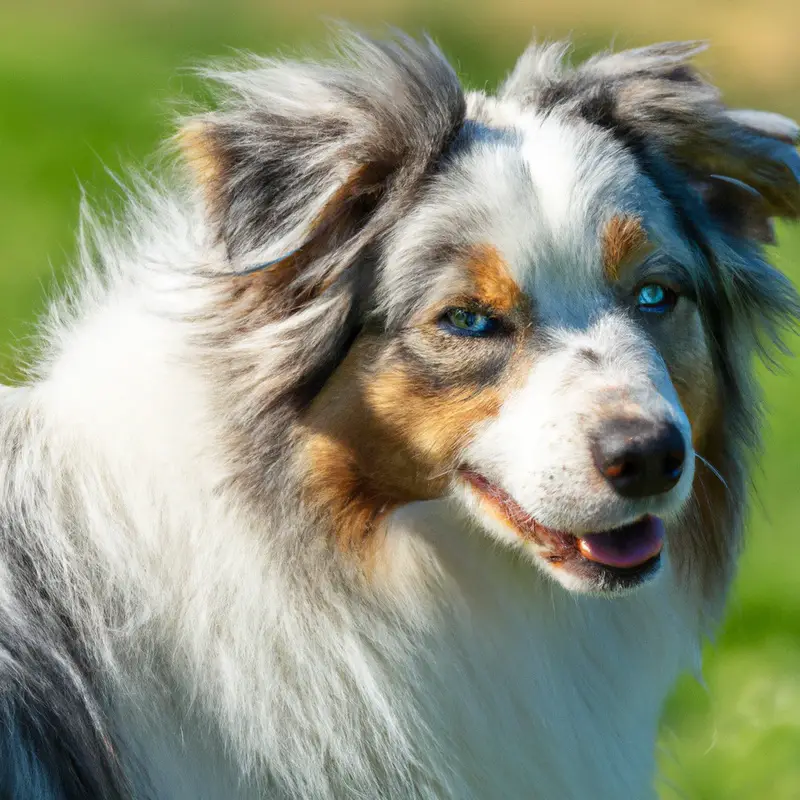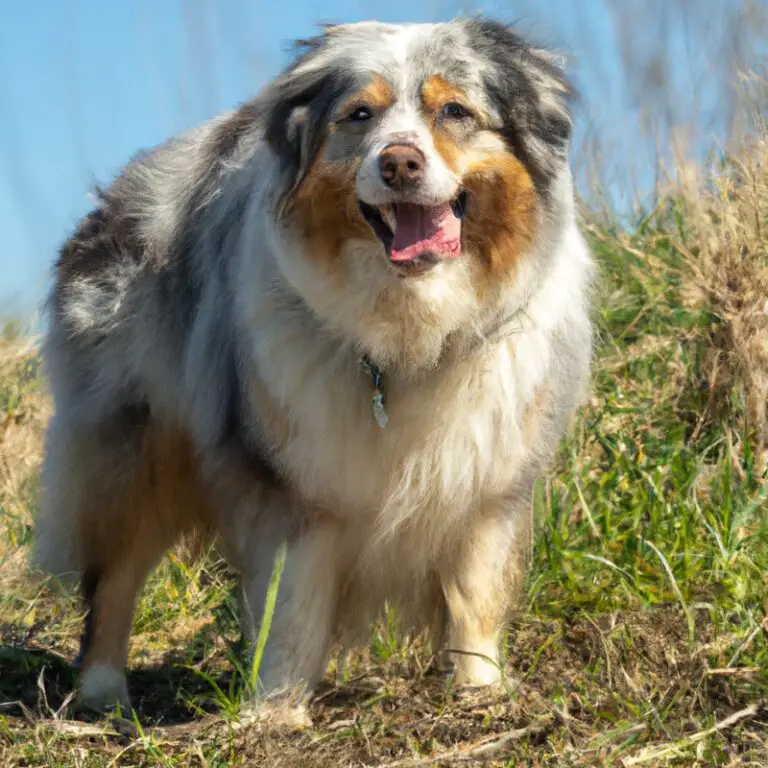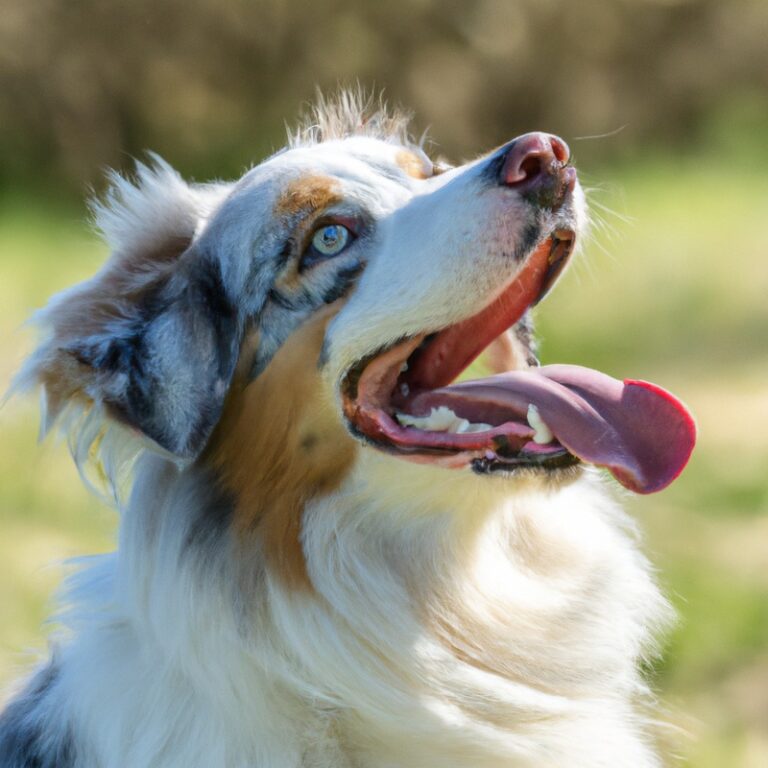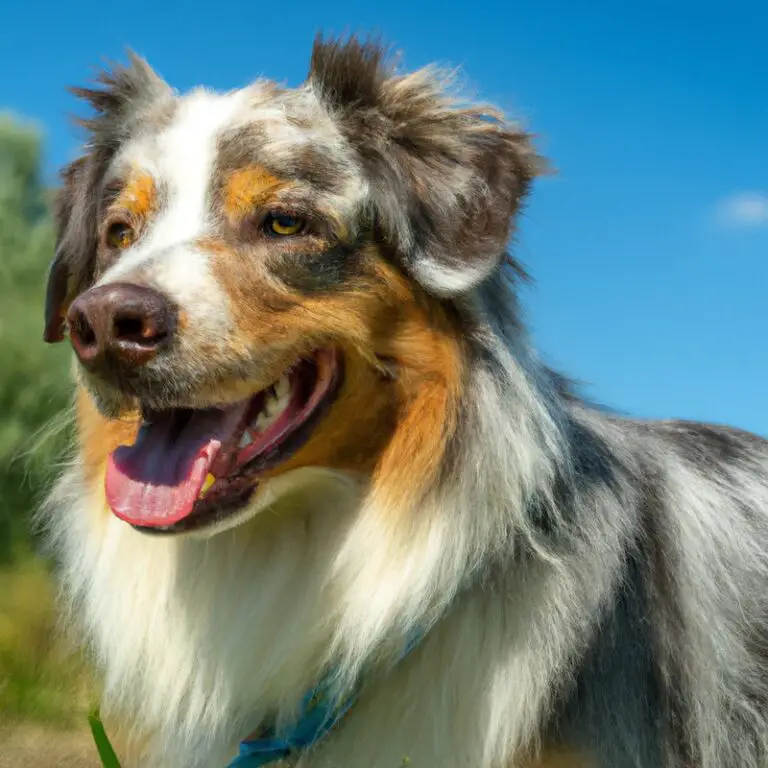Can Australian Shepherds Be Trained To Be Good With Insects Like Bees Or Butterflies?
Key Takeaways:
- Australian Shepherds can be trained to be good with insects such as bees or butterflies.
- Positive reinforcement training techniques can be used to teach Australian Shepherds to tolerate and interact with insects.
- Early socialization and exposure to insects can help Australian Shepherds become more comfortable around them.
- Training an Australian Shepherd to be good with insects requires patience, consistency, and proper guidance from an experienced trainer.
Are Australian Shepherds a match made in heaven with insects like bees and butterflies? As an expert in dog training and behavior, I’m here to shed some light on this intriguing question.
Australian Shepherds are known for their intelligence, energy, and eagerness to please, but can their natural instincts be redirected to coexist peacefully with these tiny buzzing creatures?
In this article, we’ll explore the unique characteristics of Australian Shepherds, delve into effective training techniques, and discuss precautions to ensure their safety. So, if you’ve ever wondered if your furry friend can find harmony with insects, stick around and let’s find out together!
Understanding Australian Shepherds and Their Temperament
Overview of Australian Shepherds’ Characteristics
Australian Shepherds are a breed known for their intelligence, agility, and work ethic. They are highly energetic dogs that require plenty of exercise and mental stimulation.
Australian Shepherds have a strong herding instinct and are often used on farms to manage livestock.
They are loyal and protective of their families, making them excellent watchdogs. These dogs are also highly trainable and excel in various dog sports such as obedience, agility, and flyball.
They have a medium-length double coat that requires regular grooming to keep it clean and free of tangles.
Overall, Australian Shepherds are a versatile and active breed that thrives in active households with dedicated owners who can provide them with the physical and mental stimulation they need to thrive.
Natural Instincts and Traits of Australian Shepherds
Australian Shepherds have several natural instincts and traits that make them unique and well-suited for certain tasks. They are highly intelligent and energetic dogs that thrive on mental and physical stimulation.
Their herding instinct is strong, which means they may try to herd other animals or even children.
They are known for their loyalty and protective nature towards their families, making them excellent guard dogs. Australian Shepherds are also highly trainable and excel in activities such as agility, obedience, and advanced tricks.
They require consistent training, socialization, and exercise to keep them happy and well-balanced.
Training Australian Shepherds to Interact with Insects
Introducing Australian Shepherds to Insects
Introducing Australian Shepherds to insects can be done through gradual exposure and positive reinforcement training. Start by familiarizing them with the sight and sound of insects from a distance.
Use treats and praise to reward calm behavior.
As they become more comfortable, gradually decrease the distance between them and the insects. Teach them to stay or leave it commands to prevent unwanted interactions.
Seek assistance from a professional trainer if needed.
Remember to prioritize the safety and well-being of both your dog and the insects.

Positive Reinforcement Training Techniques
Positive reinforcement training techniques are highly effective when it comes to training Australian Shepherds to interact with insects. This approach involves rewarding and reinforcing desired behaviors, which encourages the dog to repeat those behaviors in the future.
Instead of using punishment or force, positive reinforcement focuses on rewarding good behavior.
This can be in the form of treats, praise, or playtime. For example, when your Australian Shepherd approaches an insect calmly or listens to your commands, you can give them a treat or praise them.
This positive association helps them learn to associate insects with positive experiences.
Consistency is key when using positive reinforcement. It’s important to reward your Australian Shepherd every time they display the desired behavior.
This reinforces the connection between the behavior and the reward.
Another technique is clicker training, where a small device is used to make a clicking sound when the dog exhibits the desired behavior. The click is immediately followed by a reward, which helps the dog understand that the click means they did something right.
It’s important to start with simple commands and gradually increase the difficulty as your Australian Shepherd becomes more comfortable.
For example, you can start by teaching them to stay calm when they see an insect and then progress to more advanced commands, such as coming back to you when called in the presence of an insect. Remember, positive reinforcement training techniques require patience and consistency.
It’s important to create a positive and enjoyable training environment for your Australian Shepherd.
With time and practice, they can learn to coexist peacefully with insects like bees or butterflies.

Gradual Exposure and Desensitization
Gradual exposure and desensitization are key techniques when training Australian Shepherds to interact with insects like bees or butterflies. The idea is to introduce these insects in a controlled and gradual manner to help your dog become more comfortable with them over time.
Start by showing your dog pictures or videos of bees or butterflies, and reward them for calm behavior.
Next, slowly introduce the scent of these insects, using their favorite treats as positive reinforcement. Gradually increase exposure by bringing your dog closer to live bees or butterflies, while ensuring their safety.
The goal is to create positive associations and reduce fear or anxiety.
Patience is important in this process, as every dog reacts differently. Consistency and repetition are key.
With time and practice, your Australian Shepherd can learn to coexist peacefully with these fascinating creatures.
Using Commands and Obedience Training
Using commands and obedience training is an effective way to train Australian Shepherds to interact with insects like bees or butterflies. Teaching commands such as “sit,” “stay,” and “leave it” can help you control your dog’s behavior and keep them safe around insects.
By consistently practicing these commands and rewarding your dog for obeying them, you can gradually build their confidence and trust in your guidance.
It’s important to be patient and consistent with your training, as it may take time for your Australian Shepherd to fully understand and follow the commands. Seeking professional help from a dog trainer experienced in obedience training can also be beneficial in teaching your dog to interact safely with insects.
Seeking Professional Help
If you’re having difficulty training your Australian Shepherd to interact with insects like bees or butterflies, seeking professional help can be a great option. A professional dog trainer or behaviorist can provide expert guidance and support to address any specific issues you may be facing.
They have the knowledge and experience to develop a customized training plan that suits your dog’s individual needs.
Additionally, they can teach you effective techniques to help your Australian Shepherd feel more comfortable and confident around insects. Professional help can make a significant difference in your dog’s training progress and ensure a positive and safe experience for both your dog and the insects.
Teaching Australian Shepherds to Coexist with Bees
Importance of Bee Awareness and Safety Measures
Bee awareness and safety measures are crucial when it comes to training Australian Shepherds to coexist with bees. It’s important to educate yourself and your dog about bee behavior and the potential risks involved.
By being aware of your surroundings and taking precautions, you can create a safe environment for both your dog and the bees.
This includes keeping your dog away from beehives, using positive reinforcement to teach commands specific to bees, and rewarding desirable behavior around bees. Additionally, it’s important to monitor your dog’s interactions with bees and contact a veterinarian if your dog shows any signs of allergies or stings.
Overall, by prioritizing bee awareness and safety, you can ensure a positive and safe experience for both your Australian Shepherd and the bees.
Creating a Safe Environment for Australian Shepherds and Bees
Creating a safe environment for Australian Shepherds and bees is essential to promote a harmonious coexistence. Here are some key steps to ensure the safety of both your dog and the bees.
- Avoid using pesticides or insecticides in your yard as they can be harmful to bees. Opt for natural alternatives or consult with beekeepers for safe pest control methods.
- Provide a separate area in your yard for the bees, such as a designated bee garden or hive. This will help redirect your Australian Shepherd’s attention away from the bees and minimize the chances of accidental encounters.
- Train your Australian Shepherd to have a reliable recall command, like “come” or “here.” This allows you to call your dog away from any potentially dangerous situations involving bees.
- Keep an eye on your dog when they are outside, especially during peak bee activity times. Be vigilant and ready to intervene if your dog shows interest in the bees or starts chasing them.
- Teach your Australian Shepherd to respect boundaries around the bee area by using positive reinforcement techniques. Reward them for staying away or showing calm behavior around the bees.
- Consider using visual barriers, such as low fences or plants, to create a physical barrier between your dog and the bee area. This can help prevent accidental interactions and keep both parties safe.
- If your Australian Shepherd shows signs of curiosity or fear towards bees, consult a professional dog trainer or behaviorist for guidance. They can help address any specific concerns and provide tailored solutions.
Remember, creating a safe environment for Australian Shepherds and bees is a gradual process. It requires patience, consistency, and ongoing supervision to ensure the well-being of both your dog and the important pollinators in your ecosystem.
Training Commands Specific to Bees
Training Australian Shepherds to coexist with bees involves teaching them specific commands that promote safe and positive interactions. One important command is “Leave it,” which tells the dog to refrain from touching or approaching the bees.
This command should be reinforced consistently through rewards and praise.
Another useful command is “Stay,” which helps to keep the dog in place when bees are nearby. Alongside these commands, it is important to ensure that the dog receives proper obedience training and socialization to develop good behavior around bees.
Seeking professional help can also provide guidance and tailored strategies for training Australian Shepherds to be comfortable around bees.
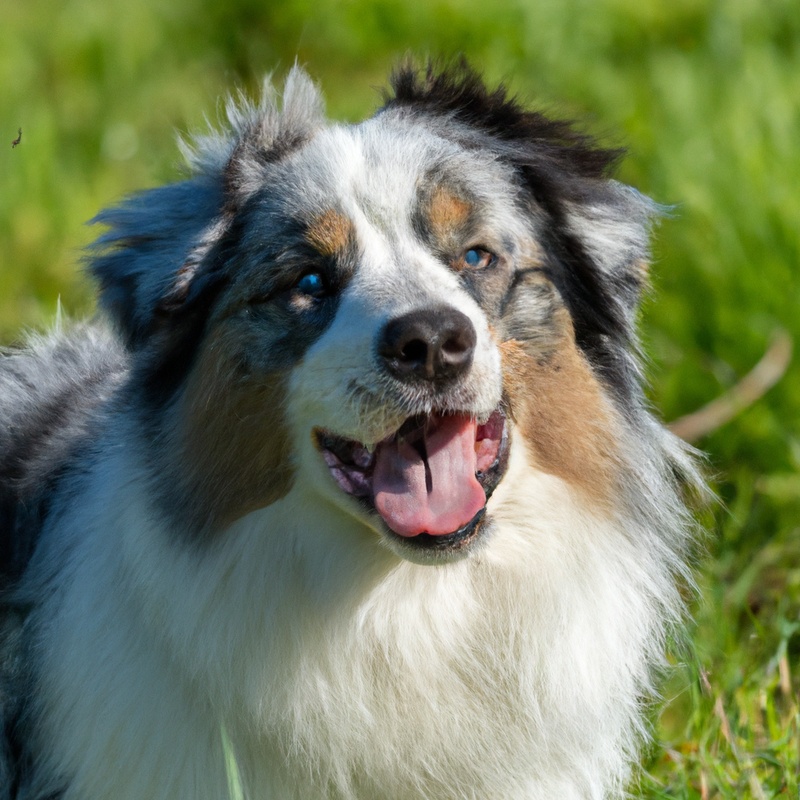
Rewarding Desirable Behavior around Bees
To reward desirable behavior around bees, it’s important to reinforce positive actions and create a positive association with bees for Australian Shepherds. When your dog displays calm behavior around bees or ignores them, offer praise, treats, or a favorite toy as a reward.
Consistency is key, so reward the desirable behavior every time.
This will help your Australian Shepherd understand that calm behavior around bees is what you want to see.
Training Australian Shepherds to Interact with Butterflies
Understanding Butterfly Behavior
Butterflies are fascinating creatures with unique behavior patterns. Understanding their behavior is important when training Australian Shepherds to interact with them.
Butterflies are attracted to bright colors and fragrant flowers, so they tend to flutter around these areas.
They have delicate wings and move in a graceful manner. It’s important to remember that butterflies are easily scared, so sudden movements or loud noises can startle them.
By observing their behavior and learning to recognize their flight patterns, we can create a calm and safe environment for both the butterflies and our Australian Shepherds.
Encouraging Calm Behavior around Butterflies
Encouraging calm behavior around butterflies is essential when training Australian Shepherds. Here are some tips to achieve this:
- Understanding Butterfly Behavior: Learn about butterflies’ flight patterns and body language. Knowing how they behave will help you anticipate your dog’s reactions.
- Teaching “Leave It” or “Stay” Commands: Train your dog to stay calm and not chase or pounce on butterflies. Use positive reinforcement techniques to reward desired behavior.
- Making the Experience Positive and Enjoyable: Gradually introduce your Australian Shepherd to butterflies in a controlled environment. Allow them to observe without being able to chase or harm the butterflies. Use treats or toys as rewards for staying calm.
Remember, every dog is different, and it may take time for your Australian Shepherd to adjust. Patience and consistency are key.
Teaching “Leave It” or “Stay” Commands
Teaching your Australian Shepherd the “Leave It” and “Stay” commands is essential for their safety and your peace of mind. To begin, start with the “Leave It” command, which teaches your dog to ignore temptations or potential dangers.
Use a treat or toy to grab their attention, say “Leave It,” and reward them when they look away.
Consistency is key. As for “Stay,” it teaches your dog to remain in place until given permission.
Start with short distances and gradually increase the time and distance.
Reward your dog for staying put. With patience and positive reinforcement, your Australian Shepherd will learn these commands and be safer around insects like bees and butterflies.
Making the Experience Positive and Enjoyable
To make the experience of training Australian Shepherds to interact with butterflies positive and enjoyable, it’s important to take a few key steps. First, create a calm and relaxed environment.
This can help your dog feel more comfortable and less likely to be overwhelmed by the presence of butterflies.
Next, use positive reinforcement techniques during training sessions. Reward your dog for calm behavior around butterflies, such as sitting or staying still.
This will help reinforce the desired behavior and make the experience enjoyable for your dog.
Additionally, consider incorporating play and games into the training process. For example, you can use butterfly-shaped toys or interactive puzzles to engage your Australian Shepherd.
This will make the training sessions more fun and enjoyable for both you and your dog.
Lastly, be patient and consistent in your training efforts. Rome wasn’t built in a day, and training your dog to interact positively with butterflies may take time and practice.
Remember to celebrate small victories along the way and adjust your training methods as needed.
Precautions and Limitations
Potential Risks for Australian Shepherds
When it comes to potential risks for Australian Shepherds, there are a few things to keep in mind. One important risk is the potential for insect bites or stings.
Some dogs may have an allergic reaction to bee or wasp stings, which can be serious and require immediate veterinary attention.
It’s crucial to monitor your Australian Shepherd closely when they are outdoors and keep an eye out for any signs of discomfort or swelling. Another risk to consider is the potential for accidental ingestion of insects like bees or butterflies.
While Australian Shepherds are generally intelligent and trainable, they can still be curious and may try to catch or play with insects.
Ingesting an insect, especially if it has been sprayed with pesticides or is toxic, can lead to digestive issues or poisoning. It’s important to discourage your dog from chasing or consuming insects and redirect their attention to more appropriate toys or activities.
Additionally, Australian Shepherds are known for their high energy levels and need for exercise.
While interacting with insects like bees or butterflies may be stimulating for them, it’s crucial to ensure that they do not become too excited or overstimulated. This can lead to accidental injury or an unsafe environment for both your dog and the insects.
It’s important to supervise their interactions closely and provide them with appropriate outlets for their energy, such as regular walks, playtime, or training sessions.
Monitoring and Supervising Interactions
Monitoring and supervising interactions between Australian Shepherds and insects like bees or butterflies is essential to ensure their safety and the well-being of the insects. I pay close attention to my Australian Shepherd when they are around insects, especially if they show signs of curiosity or excitement.
I stay vigilant to prevent my dog from chasing or trying to catch the insects, as it can lead to stings or harm to the insects.
It’s important not to leave my dog unattended with insects, as they may unintentionally harm themselves or the insects. I make sure to keep a reasonable distance between my dog and the insects, allowing them to observe from a safe distance without direct contact.
If my dog gets too close, I calmly redirect their attention to a different activity or command.
I also closely observe my dog’s body language for any signs of stress or discomfort, such as raised hackles, pacing, or excessive panting. If I notice any signs of fear or anxiety, I intervene by removing my dog from the situation and providing positive reinforcement for calm behavior.
Additionally, I avoid using insecticides or repellents around my dog, as they can be harmful if ingested or exposed to the dog’s skin.
Instead, I focus on creating a safe and positive environment for my Australian Shepherd and the insects. Overall, monitoring and supervising interactions between Australian Shepherds and insects is crucial to ensure their safety and foster a positive relationship with these creatures.
By staying attentive and proactive, I can minimize any potential risks and create a harmonious coexistence.
Just remember to prioritize safety and the well-being of both your dog and the insects.
Contacting Veterinarian for Allergies or Stings
If your Australian Shepherd experiences an allergic reaction or gets stung by an insect like a bee or butterfly, it’s important to contact a veterinarian. Allergic reactions can vary in severity, from mild itchiness and swelling to more severe symptoms like difficulty breathing.
A veterinarian can assess the situation and provide the appropriate treatment or medication to alleviate your dog’s discomfort.
They may also advise you on preventive measures or steps to take in case of future allergic reactions or stings. Remember, it’s better to err on the side of caution and seek professional help to ensure your Australian Shepherd’s well-being.
Considering Personal Limitations and Safety Measures
Considering Personal Limitations and Safety Measures is paramount when training Australian Shepherds to interact with insects like bees or butterflies. Here are some important points to keep in mind:
- Know your own limitations: It’s important to assess your comfort level and knowledge about handling insects like bees or butterflies. If you have allergies or fear, it may not be safe or enjoyable for both you and your Australian Shepherd to engage in such training.
- Safety first: Always prioritize safety when working with insects. Ensure that the insects used for training are non-aggressive and pose no harm to your Australian Shepherd or yourself. Avoid using live insects that can sting or bite.
- Take it slow: Gradually introduce your Australian Shepherd to insects in a controlled environment. Start with visual exposure, using pictures or videos, to gauge their reaction and comfort level. Only progress to in-person interactions when your dog appears calm and relaxed.
- Positive reinforcement: Use positive reinforcement techniques to encourage desirable behavior around insects. Reward your Australian Shepherd with treats, praise, or play when they remain calm and show interest without displaying aggression or fear.
- Supervision is key: Always supervise your Australian Shepherd during training sessions with insects. This ensures their safety and allows you to intervene if any unwanted behavior occurs. Additionally, keep training sessions short and frequent to avoid overwhelming your dog.
- Consider professional help: If you’re unsure about how to safely train your Australian Shepherd to interact with insects, consider seeking assistance from a professional dog trainer. They can provide guidance, personalized training plans, and help ensure the safety of both your dog and the insects.
By considering these personal limitations and implementing proper safety measures, you can create a positive and enjoyable experience for both your Australian Shepherd and the insects they interact with. Remember, every dog is different, so be patient and adjust your approach based on their individual temperament and reactions.
Final Verdict
Australian Shepherds can absolutely be trained to coexist with insects like bees and butterflies. By utilizing positive reinforcement techniques, gradual exposure, and obedience training, these intelligent and eager-to-learn dogs can develop a calm and respectful approach towards insects.
It is crucial to prioritize safety measures, create a safe environment, and monitor interactions to prevent any potential risks.
Remember to consult a veterinarian for allergies or stings and always prioritize the well-being of your Australian Shepherd. With patience, consistency, and proper training, your Australian Shepherd can develop a harmonious relationship with insects while maintaining their natural curiosity and instincts.

